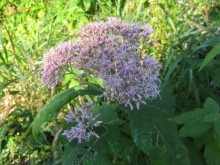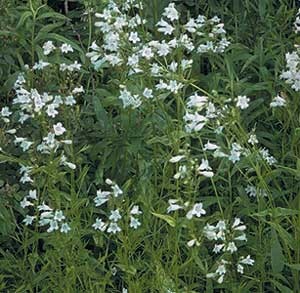Product Description
“Sweet Joe Pye Weed, Boneset, Gravel-root, Hempweed, Jopi Root, Jopi Weed, Kidney Root, King-of-the-Meadow, Queen-of-the-Meadow, Marsh Milkweed, Motherwort, Quillwort, Skunk Weed, Stink Trumpet Weed, Quillwort and others”

Greek, from the name of the King of Pontus, Eupator and the Latin purpureum for “purple”.
Found throughout the Tallgrass Region at the edge of wet places where woodlands open into thickets and marshes. Blooms from July through September on erect stems to ten feet tall. Occasionally, the green stem is mottled with purple that shades to a deep purple at the leaf joints. When crushed or dried, the stem and leaves give off a vanilla-like odor. Flowers are tiny and grow in dome-like clusters up 8 inches across. Flowers are creamy white to pale pink or pale purple. Short petals and long stamens give them a frilly appearance
The astute reader will note that both E. maculatum and E. purpureum are called Joe Pye Weed. The main difference is in the flower heads with E. purpureum being more dome-shaped.
This plant is one of the great stories in Native American medicine. It is named after the east coast Native American, Joe Pye, a member of the Massachusetts Bay Colony, who used the plant to cure fevers. It is still used in parts of Appalachia to treat urinary disorders. Some mothers bathed their fretful children in a tea made from Joe Pye Weed to calm them down and bring on a restful sleep. Meskwaki men would nibble the leaves of this plant to ensure success while wooing chosen tribal maidens. We cannot report on the success of this particular usage.
Edible Uses: The roots have been burnt and their ashes used as salt to flavour foods.
Medicinal Uses: Gravel root was used by the native N. American Indians as a diaphoretic to induce perspiration and break a fever. The plant was quickly adopted by the white settlers and still finds a use in modern herbalism. The whole plant, but especially the root, is astringent, diuretic, nervine and tonic. It works particularly on the genito-urinary system and the uterus. Especially valuable as a diuretic and stimulant, as well as an astringent tonic, a tea made from the roots and leaves has been used to eliminate stones from the urinary tract, to treat urinary incontinence in children, cystitis, urethritis, impotence etc. It is also said to be helpful in treating rheumatism and gout by increasing the removal of waste from the kidneys. The leaves and flowering stems are harvested in the summer before the buds open and are dried for later use. The roots are harvested in the autumn and dried for later use.
Other Uses: The stems have been used as straws.
The fruits yield a pink or red textile dye.
Herbal Uses: Unknown
To Purchase This Top 2013 Wildflower Visit Us At Ion Exchange, Inc.









